
Pet Care Marketing: Tactics, Strategies & Examples [2025]
Remember when running a pet care business just meant putting up a sign and letting the wagging tails roll in?
Well, those days are over. Today’s pet parents are a different breed. They treat their furry friends like family, scroll through reviews, and expect top-notch care, whether it’s grooming, boarding, training, or pet supplies.
If your business isn’t showing up or standing out, you’re not just missing sales; you’re also missing opportunities. You’re missing a chance to build real loyalty with modern pet lovers.
In this post, we’ll break down the benefits of investing in pet care marketing and the tactics you can use to promote your business, including email, social media, SEO, and more.
The Benefits of Marketing for Pet Care
Marketing isn’t only about flashy ads or viral dog videos (though, let’s be honest, those help), but creating memorable experiences and staying visible when pet parents need you most.
Before we explore the best pet care digital marketing strategies to achieve this, let’s look at the benefits.
Attract new customers
When someone types “pet grooming near me” into Google, they are looking for a solution to their specific pain point.
If your business shows up in those top results, like Petco or Petbarn do in the example below, you’re in the running. If not? You’re sadly out of sight and out of mind.
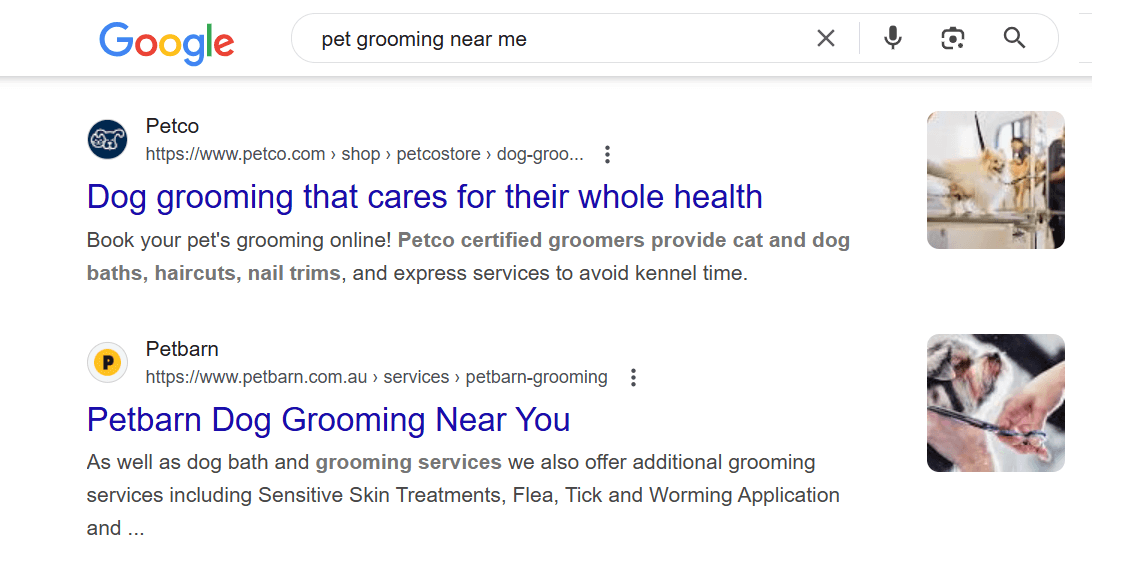
That’s where strong pet care marketing comes in. Local SEO helps you appear when it matters most, while eye-catching Reels or well-placed ads turn curious pet parents into new customers.
Build loyalty with pet parents
Pet parents stick with brands they trust. And that trust is built through consistent and valuable communication.
For example, as a pet owner myself, I found a pet supplies store I felt good about, and I’ve stuck with them ever since. Not just because they have everything I need, but also because they keep me informed.
I get reminder emails when it’s time to restock, SMS updates about special offers, and even the occasional “treat your pet” message that feels personal.
This type of communication keeps your brand top of mind and encourages customers to return.
Encourage referrals and word-of-mouth
One of the biggest benefits of great marketing is that you don’t always have to do the talking yourself. Your happy customers do it for you.
When pet parents have a great experience, they’re quick to recommend your business to friends, family, and fellow pet lovers.
And with the right marketing in place, such as referral rewards or easy social sharing, you can turn that natural word-of-mouth into a steady stream of new business.
Stand out in a crowded pet care market
The U.S. pet industry is thriving, with pet parents spending over $65 billion on food and treats alone, according to APPA. That’s a massive market, but it also means more competition than ever.
Pet care marketing can highlight what makes your business special and help you build real connections with pet parents who are ready to buy.
This way, customers remember you, trust you, and choose you over the competition.
Establish your brand as an expert
Apart from building loyalty and attracting new customers, marketing for pet care gives you the opportunity to share your expertise through videos, blog content, or email.
For example, tips on coat care, training basics, or safety tips not only help customers but also position you as a trusted voice in pet care.
Here’s an example from Will Atherton Academy, showing how to survive the first 24 hours with a new puppy:
Content like this can help you become the go-to expert they rely on, not just for products or services, but for advice they can trust. And that trust turns into loyalty.
Drive more revenue through upsells and promotions
When you’ve started building trust, marketing provides a natural way to highlight those little extras, such as treatment upgrades, training add-ons, or special pet packages.
A quick email, text, or social post can remind pet parents what else you offer and make it easy for them to treat their furry friend. It’s a simple way to turn everyday visits into something more special and more profitable.
Best Pet Care Marketing Tactics
Now that we’ve covered why marketing matters for pet care businesses, let’s see how to do it.
In the sections below, we’ll walk through the most effective pet care marketing tactics, from email and SMS to SEO and more. You’ll see real-life examples, tips to personalize your strategy, and ideas you can put into action, even if you’re a one-person show.
Email Marketing
Email is one of the easiest ways to stay in touch with your customers, without relying on the algorithm or waiting for them to scroll past your post.
It’s direct, personal, and still one of the most effective marketing tools for nurturing one-time visitors into loyal customers.
Regardless of your goal, email marketing helps you:
- Stay top-of-mind: 93% of users use email every day, including pet owners. A quick reminder or offer can nudge them to book or order supplies again before they forget.
- Offer personalized experiences: You can group your emails by service, pet size, or visit history. That way, a dog food promo won’t go to someone who just bought cat supplies.
- Run things on autopilot: You can automate pet birthday emails, replenish messages, appointment follow-ups, or even rebook appointments, saving time while maintaining a personal touch.
- Collect data: Email allows you to track important marketing metrics, such as opens, clicks, and conversions, to determine what works. This will help you improve your messaging and your product or service.
Now that you know why email marketing is a great fit for pet care businesses, let’s look at the different types of emails you can send and some examples to get you inspired.
Seasonal offers and flash sales
Seasonal promotions are a great way to boost product sales, drive bookings, and showcase new services or pet care items. You can promote everything from spring shed-out packages and summer paw protection to holiday-themed grooming or limited-edition toys.
Flash sales operate similarly, but with an added sense of urgency. They’re perfect for filling last-minute slots, clearing seasonal inventory, or creating hype around a limited-time offer.
What to include:
- A themed offer or limited-time bundle
- Clear sale timeline or urgency
- Eye-catching visuals
- An actionable CTA
Here’s a themed promotion by Meowingtons:

The brand ran a festive seasonal promo featuring limited-edition handcrafted Christmas Tree Cat Caves. The campaign employed urgency (offering very low quantities), a holiday-themed discount code (HOHOHO), and a compelling story about supporting women artisans.
Combined with playful visuals and exclusive designs, it created a compelling reason to shop early and gift consciously.
Further reading: Take a look at these flash sale email templates to start planning yours.
Event announcements and giveaway emails
Whether it’s a pet birthday bash, adoption day, or National Dog Day celebration, events help you connect with pet parents in real life or online.
Pairing them with a giveaway just adds excitement to your campaign. If you run a cross-promotion between email and social media, you can expand your reach and enjoy further benefits, such as growing your email list.
What to include:
- In-store event descriptions
- Online giveaways (steps, prizes, conditions)
- Partnerships with other brands, nonprofits, and more.
Events and giveaways showcase personality, promote goodwill, and encourage people to talk about your business for all the right reasons.
Here’s an example from Jinx:

Their National Pet Month campaign cleverly combines purpose with promotion. By donating 5% of Walmart purchases to the USO’s Canine Program, they turned a seasonal event into a cause-driven giveaway.
This built brand goodwill, encouraged purchases, and gave pet parents a reason to support them during a specific time frame.
Educational campaigns
Everyone loves a good tip, especially new pet parents trying to figure things out. From how to groom their pets properly to avoiding those dreaded hairballs, helpful content can help you nurture your audience by placing your brand as the solution to their pain point.
And it’s not just for groomers or trainers. If you sell pet food, toys, supplements, or accessories, sharing advice helps your audience feel more confident and more connected to your brand.
What to include:
- Tips and how-tos (videos, blog posts, etc.)
- Product education
- Seasonal advice (e.g., hot weather, travel tips)
- Use-case examples
Here’s an example from Elevate Pet Provisions:

The pet care brand used this campaign to educate pet parents on how their dogs’ diets affect their skin, positioning their products as part of the solution. It’s informative without being pushy, featuring a clear CTA and a list of key takeaways.
The layout balances education and product, offering value first, then guiding readers to shop. This is a great example of utilizing expert content to establish trust, drive traffic, and support product sales, all while enabling customers to make informed decisions.
Types of automations to use for pet care
Email marketing automation is like having a reliable assistant who never forgets to follow up, send a reminder, or celebrate a pet’s birthday. But it gets even better when you add segmentation.
Let’s say someone signs up on your site or makes a purchase. Instead of sending the same generic emails to everyone, you can segment based on pet type, behavior, or preferences, and send content that actually matters to them.
A cat owner who gets tips about dogs might ignore your emails altogether. But if they receive grooming advice, toy suggestions, or refill reminders tailored to their cat? That’s when engagement goes up.
Here are the key automations every pet care business should have on autopilot.
1. Welcome email sequence
Your welcome message is your first real introduction and your chance to guide new customers or subscribers through what makes your brand special.
Instead of a single quick hello, a short email series helps you build trust, share value, and guide them to their next step.
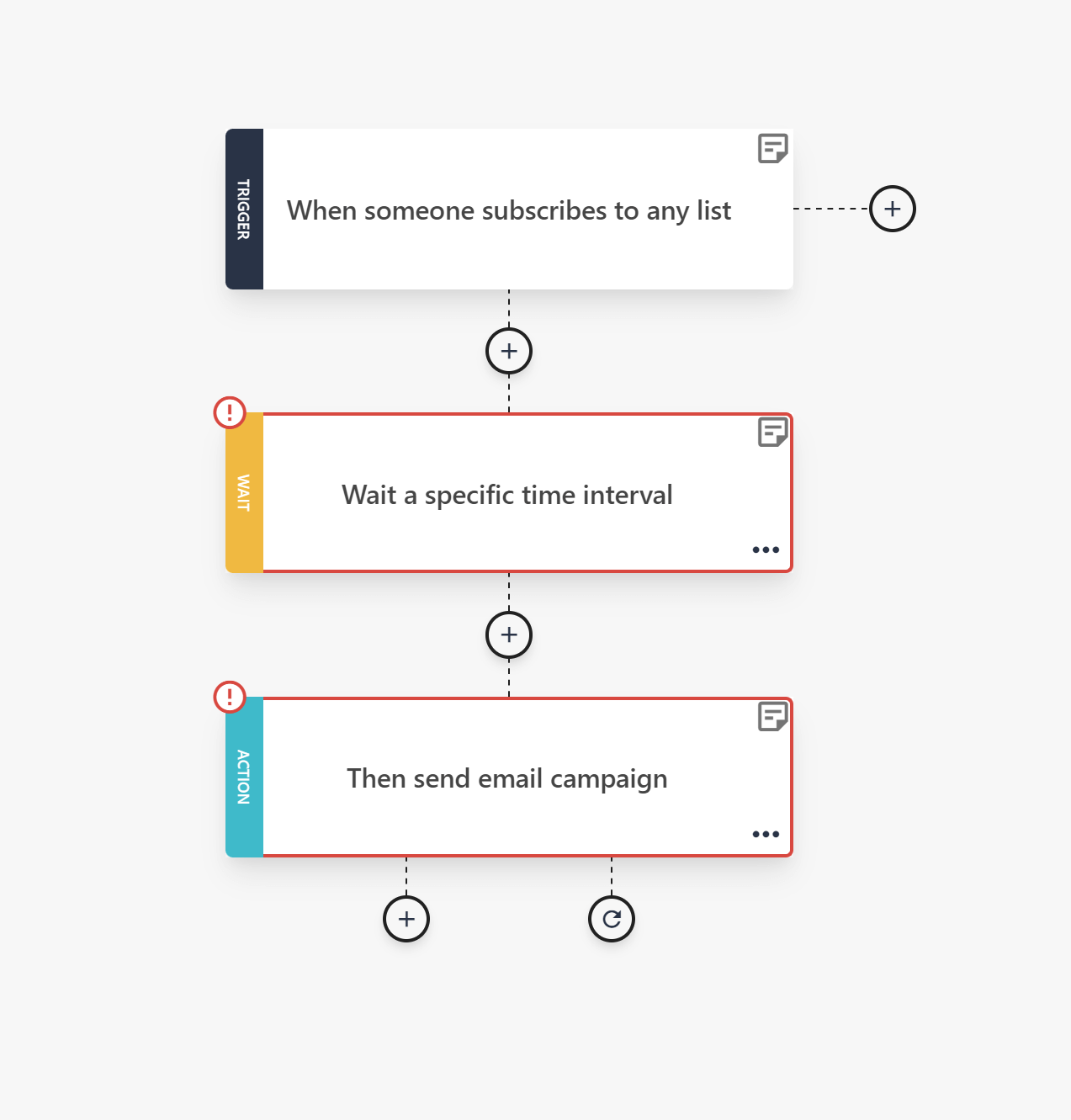
Here’s a sequence example:
- Email 1: Thank them for joining. Briefly introduce your brand and offer a first-time discount or incentive.
- Email 2: Share your mission, core services or products, and what they’ll get from being on your list (tips, offers, early access).
- Email 3: Highlight top-rated products or encourage them to book a service with a clear CTA.
- Email 4: Share reviews, customer photos, or FAQs. Let them know how to reach you if they have any questions.
Further reading: You can use these welcome email examples to get inspired and then start creating yours with our welcome email templates.
2. Cart abandonment series
Not every shopper who clicks “add to cart” is ready to buy, but that doesn’t mean they’re gone for good.
A well-timed cart abandonment email series can turn hesitation into conversion, especially when it’s personalized and helpful.
This works whether you’re selling grooming packages, training sessions, toys, treats, or supplements.
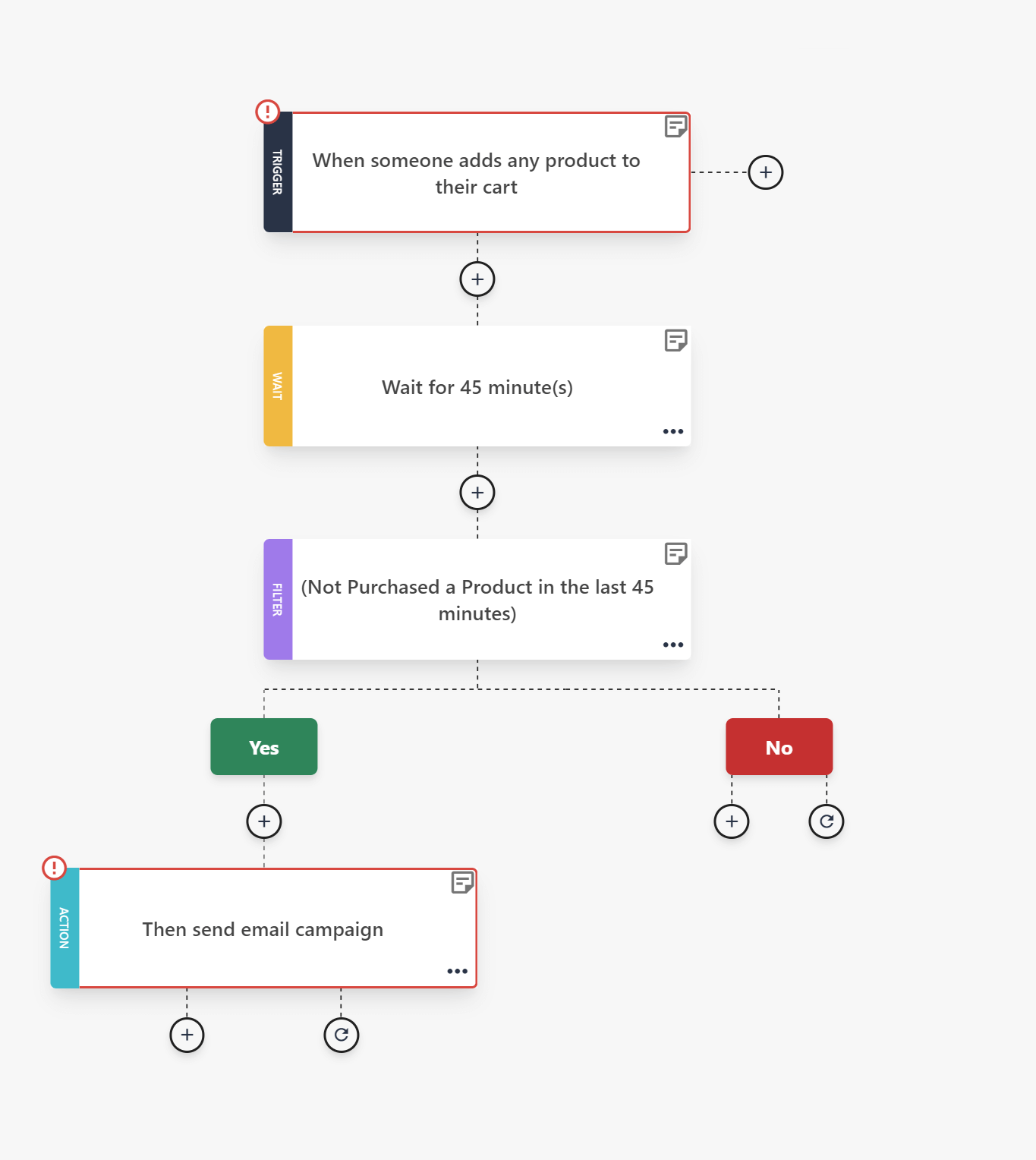
Your cart abandonment email series can look like this:
- Email 1: A quick, friendly nudge with a photo of the product or service, pricing, and a one-click return to their cart.
- Email 2: A reminder of why your product or service is worth it. Also, consider adding FAQs or a brief testimonial to help alleviate hesitation.
- Email 3: A time-sensitive discount with a countdown timer or free shipping.
3. Replenishment emails
If pet parents need to buy your products or services every single month, replenishment emails are a no-brainer.
Instead of waiting for customers to run out, you proactively remind them it’s time to restock, saving them the hassle and keeping your brand top of mind.
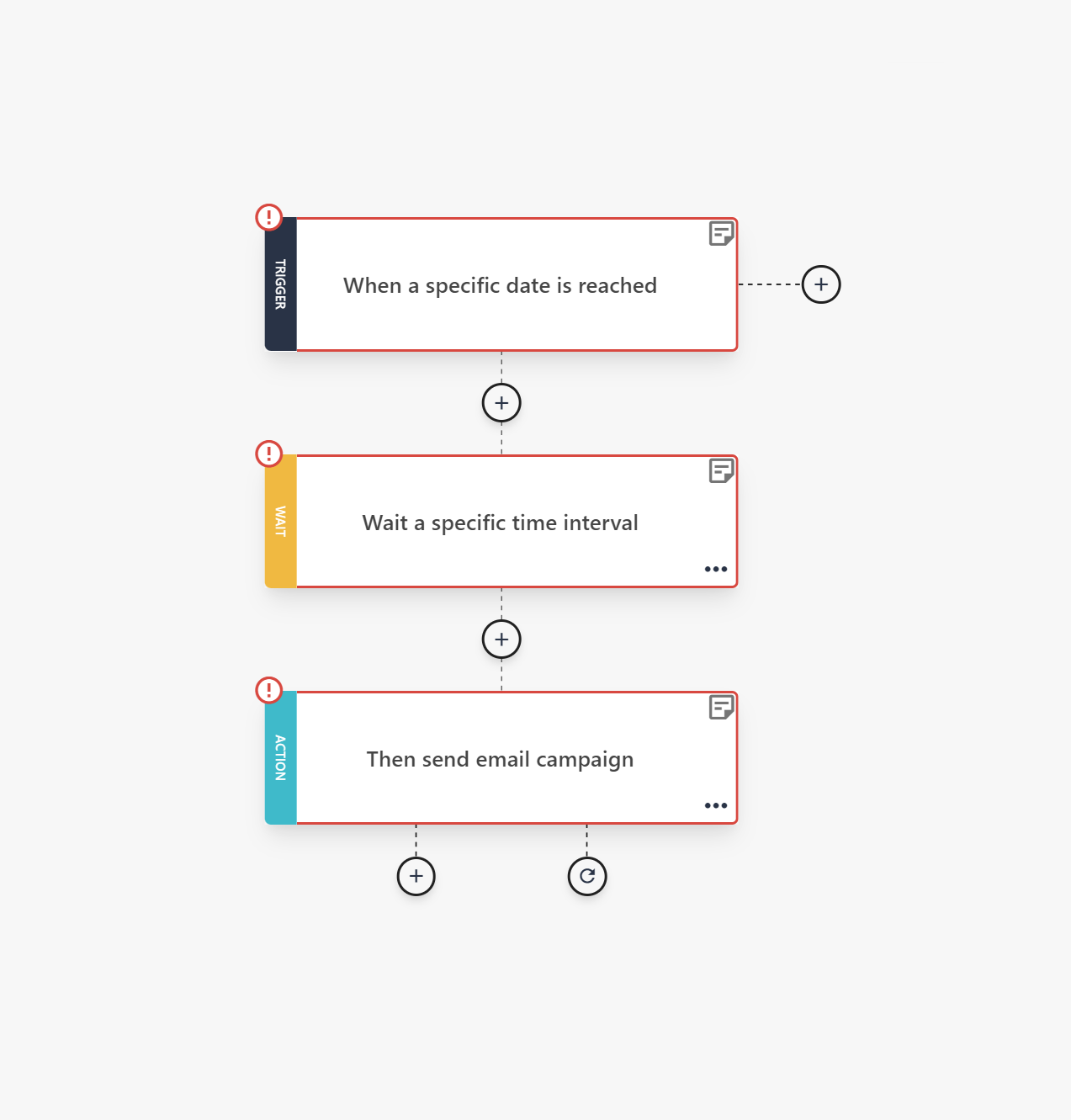
Your replenishment email flow can look like this:
- Email 1: A friendly heads-up that they’re likely running low based on past purchases. Include the product, pricing, and a one-click reorder button.
- Email 2: A gentle follow-up reminding them how easy it is to restock. Add a benefit-focused line (e.g., “Keep rewarding Max with his favorite treats”) or even a product tip.
4. Upsell & cross-sell series
An upsell or cross-sell email series introduces customers to products or services that naturally complement what they’ve already purchased or booked.
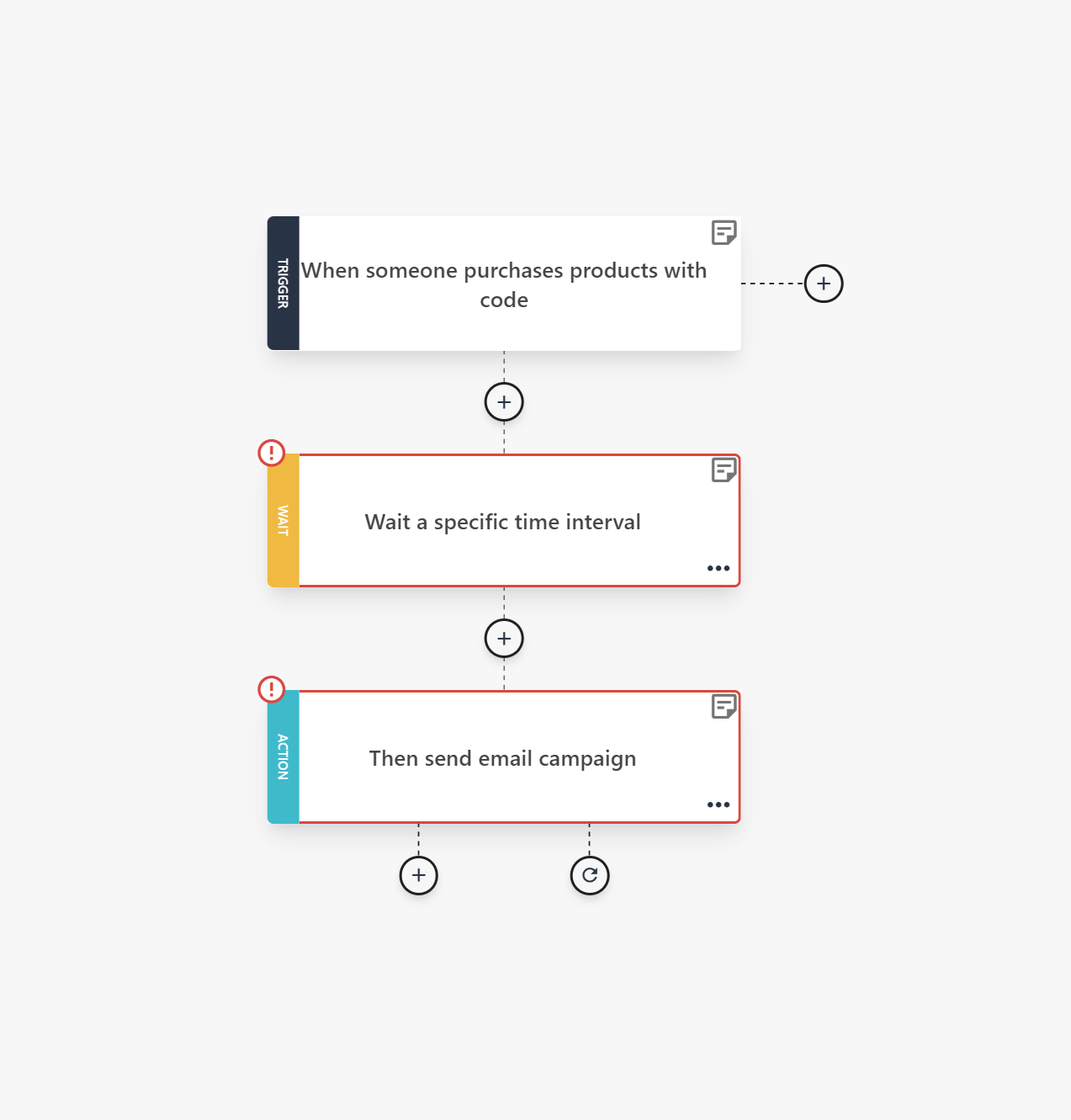
Done right, it feels helpful and boosts both customer satisfaction and average order value.
- Email 1: Show a related product or service based on what they have just bought. For example, you can suggest something that complements their recent purchase (e.g., they bought dog food; you recommend dental chews).
- Email 2: Promote an upgrade or bundle deal. This is your opportunity to offer more value while increasing the average order value (AOV). For example, they booked a daycare pass; you promote a premium package with added playtime or grooming add-ons.
This works whether you’re selling grooming upgrades, training add-ons, toys, supplements, or subscription boxes.
5. Appointment confirmations and reminders
They might seem small, but confirmation messages are key moments in your customer’s journey. They reassure pet parents that everything’s set and help you avoid costly no-shows.
Reminder emails also give customers time to reschedule if needed, without the need for awkward follow-up calls or last-minute gaps in your calendar.
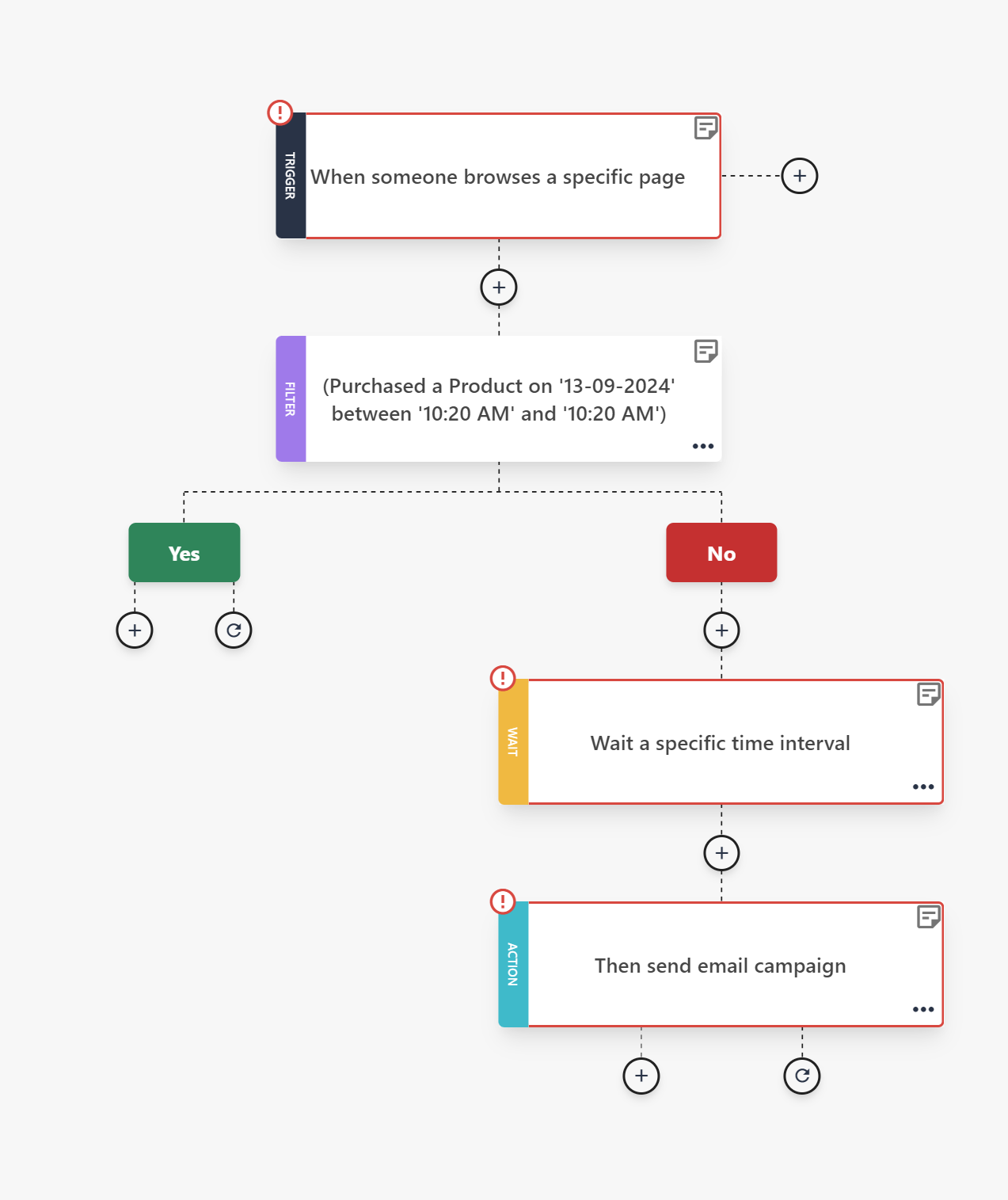
- Appointment confirmation: Sent instantly after booking. Include the date, time, service details, location (with a map), and any necessary items to bring. Keep it clear and warm, like “Can’t wait to see Max for his spa day!”
- 24/48-hour reminder: A friendly reminder with a “reschedule” button if plans change. Add a tip too, such as “Coming in for grooming? A short walk before helps them settle in.”
- Same-day reminder (optional): Send a short, mobile-friendly nudge: “See you and Luna at 3:30 PM today! Just a reminder to bring her favorite toy.”
Email design and copy tips for pet care email marketing campaigns
Good design and copy can make the difference between “Delete” and “Buy now.”
Keeping things clear, friendly, and pet-parent-focused is key to creating a converting email campaign. Here are a few tips to follow.
- Keep it mobile-first: Since pet parents check email on their phones, use a single-column layout, large fonts, and tappable buttons.
- Use high-quality pet images: Whether it’s a happy pup post-grooming or a product in use, make it visually appealing and scroll-stopping.
- Add plenty of white space: Don’t cram too much in. Let your message breathe and focus on one goal per email.
- Be consistent: Stick to your colors, tone, and logo so readers instantly recognize you.
- Have one clear button: Don’t confuse readers. Whether it’s “Book Now” or “Shop Treats,” make the next steps obvious.
- Use active, benefit-driven language: Instead of “Learn More,” try “See How Max Can Relax” or “Get Healthier Skin for Bella.”
- Make it stand out: Use buttons, bold colors, or spacing to highlight your CTA. Make sure it’s mobile-friendly and easy to tap.
- Find the right placement: Ideally, add one near the top for fast readers and one at the end for those who scroll.
Regarding email copy:
- Write like a human: Maintain a friendly, helpful tone that aligns with your brand personality.
- Add a clear value proposition: Make the benefit immediately apparent. “Treat your pup to a spa day” is more effective than “Introducing our new grooming package.”
- Use pet names when possible: Personalization increases engagement. “Is Max due for a checkup?” feels more relevant than a generic message.
- Test subject lines: Try a variety of playful, urgent, and benefit-driven headlines. Example: “Luna deserves this” or “Don’t forget your 10% off.”
Here are a few great subject line examples from pet care brands:
- A Healthier Dog Doesn’t Have to Cost More 🐾
- Tired of Empty Calories? Try Backyard Bites Instead!
- Which type of pet-lover are you?
- Love Your Pet Day every day 🐶🐱
- 🙀 $10 OFF Waterproof Pet Blankets 🙀
- Raise Awareness This Month for Our Pups
Further reading: For more, check our subject line best practices and tips.
Email newsletter templates
For busy pet care businesses, email templates are a lifesaver. They help you send polished, on-brand messages without having to start from scratch every time.
This way, you can focus on more pressing matters and save valuable time.
Below, let’s see some quick designs from Moosend’s template library that you can customize.
Out of stock template
This playful out-of-stock email template is ideal for pet care brands selling popular products, such as treats, supplements, or seasonal items. With a fun color palette and clear CTA button, it keeps customers engaged even when items are unavailable.
Use it to build urgency, collect interest, and turn stockouts into a chance to reconnect when you’re restocked.
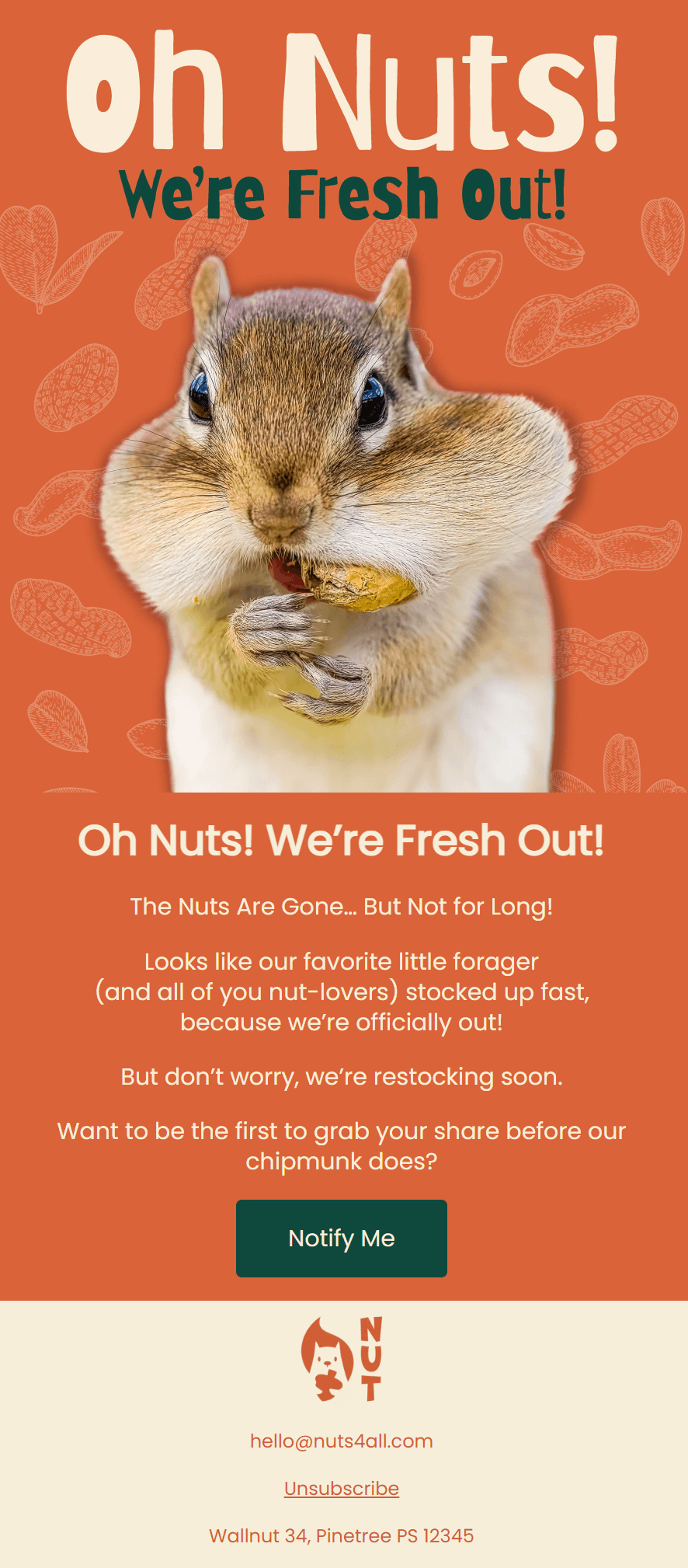
Also, it works just as well for sold-out grooming slots or limited services.
Email address confirmation
This clean and playful confirmation email is ideal for verifying a new customer’s email address after they sign up or create an account.
Pet care brands can easily adapt this transactional email for confirming bookings, newsletter sign-ups, or account setups, adding a personal touch with pet names or service details for extra charm.
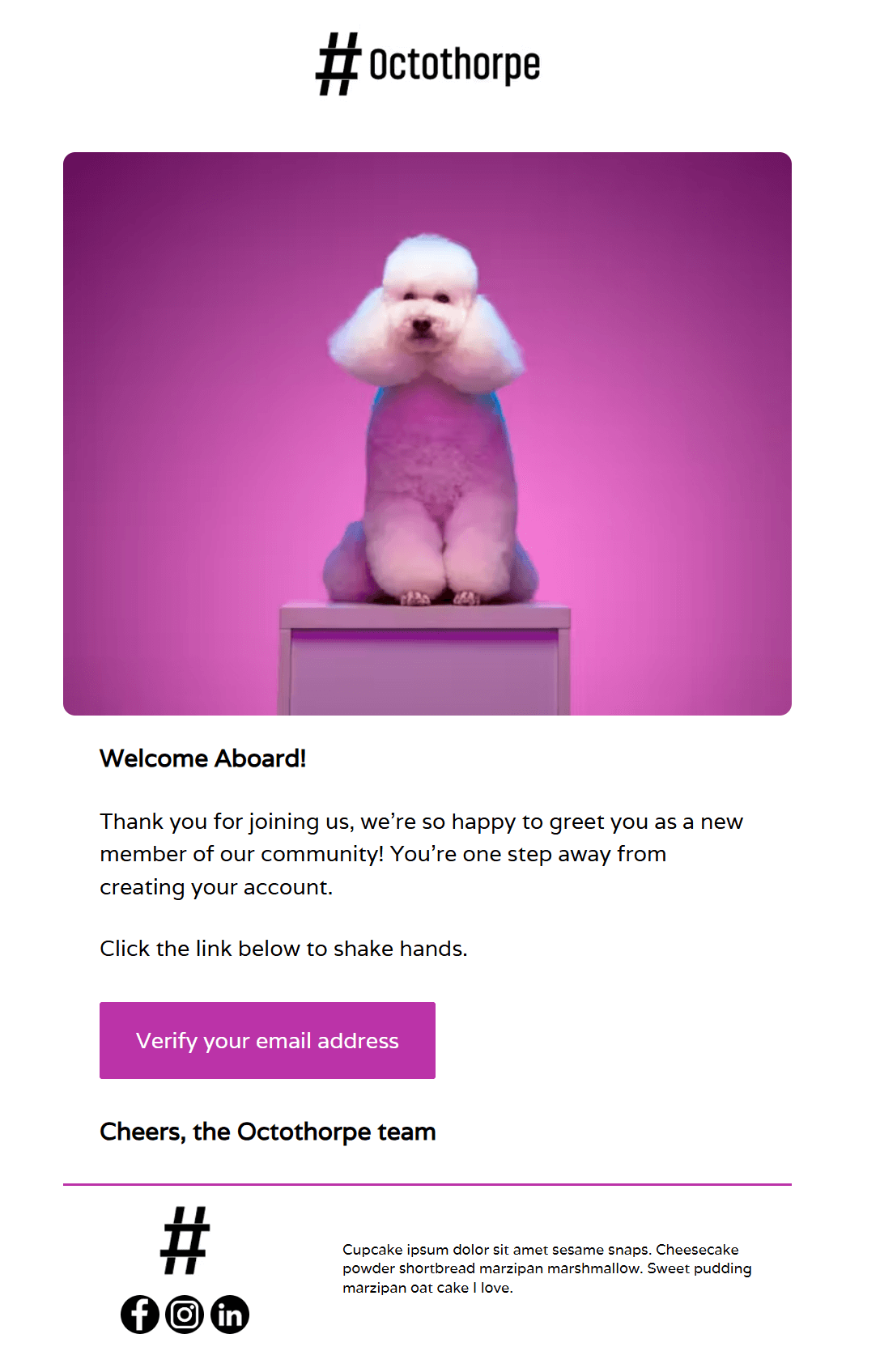
Welcome email template
This flexible welcome email template is perfect for introducing new subscribers to your pet care brand or services. With space for community highlights, resources, and social links, it’s ideal for setting expectations and guiding new contacts toward engagement.
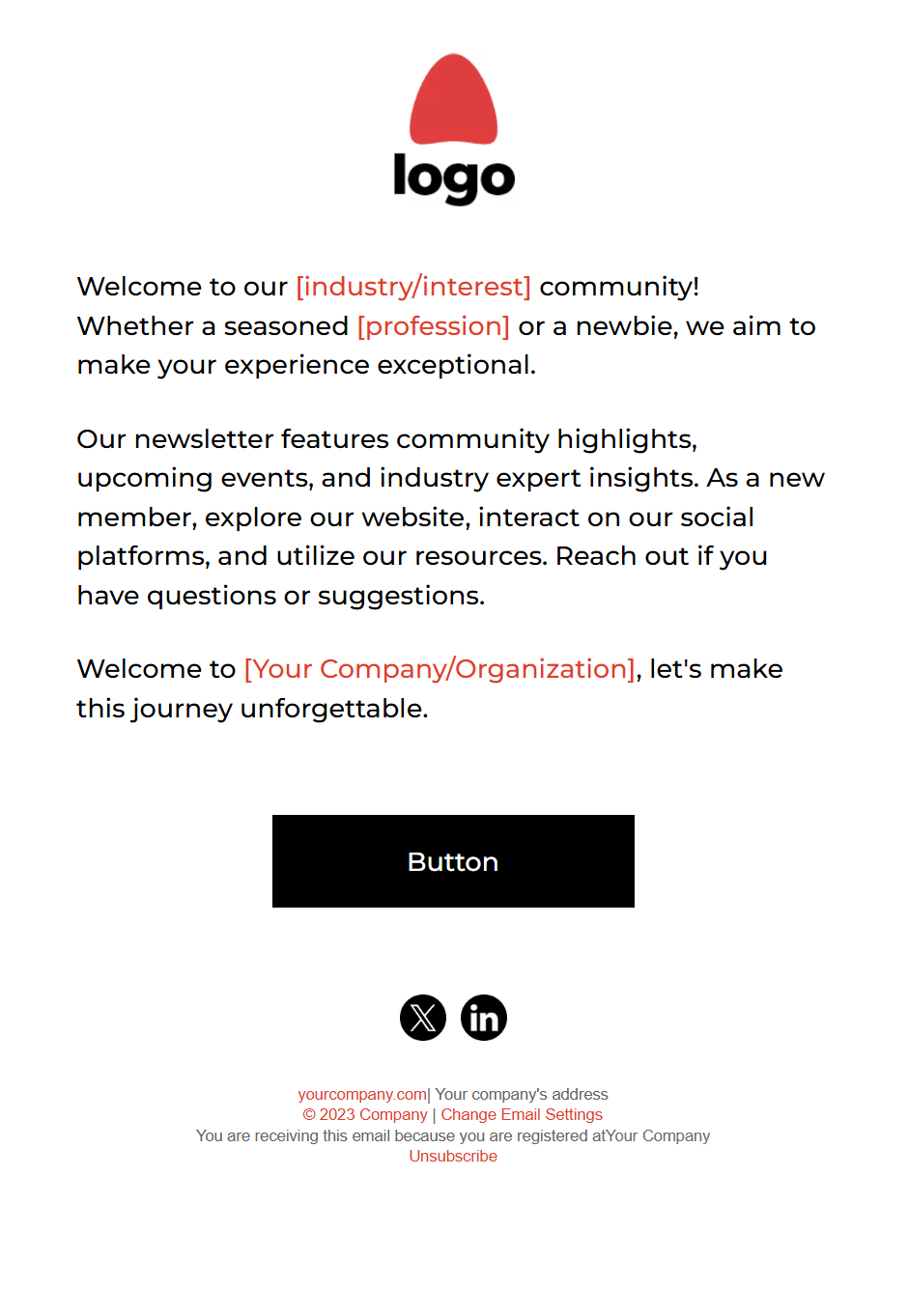
Pet grooming salons, trainers, or pet product brands can easily tailor their copy to highlight what’s unique, such as pet care tips, seasonal offers, or loyalty programs.
Social Media & Influencers
Email builds loyalty behind the scenes, but social media marketing is where your brand shows up in real-time and where your personality shines.
From everyday posts to influencer shout-outs and targeted ads, social media can help you stay visible, engage your audience, and turn followers into customers.
Let’s see how to do it.
Find the right platforms
Not every social platform is right for every pet care business, and that’s okay. The key is to focus on where your audience is most active and where your content naturally fits.
As a general rule, choose platforms that align with your goals and your preferred communication style.
For example:
- Instagram & TikTok: Ideal for showcasing grooming before-and-after results, pet tips, and engaging videos. Use Reels and Stories for high engagement.
- Facebook: For community updates, events, and local promotions, particularly for services such as training or daycare.
- Pinterest: For product brands (toys, food, supplements) and blog content.
- YouTube: Best suited for educational content, such as how-to guides or behind-the-scenes footage.
Here’s an example from family-owned pet food company Weruva, which uses Instagram Reels to engage its audience with fun and meaningful content.
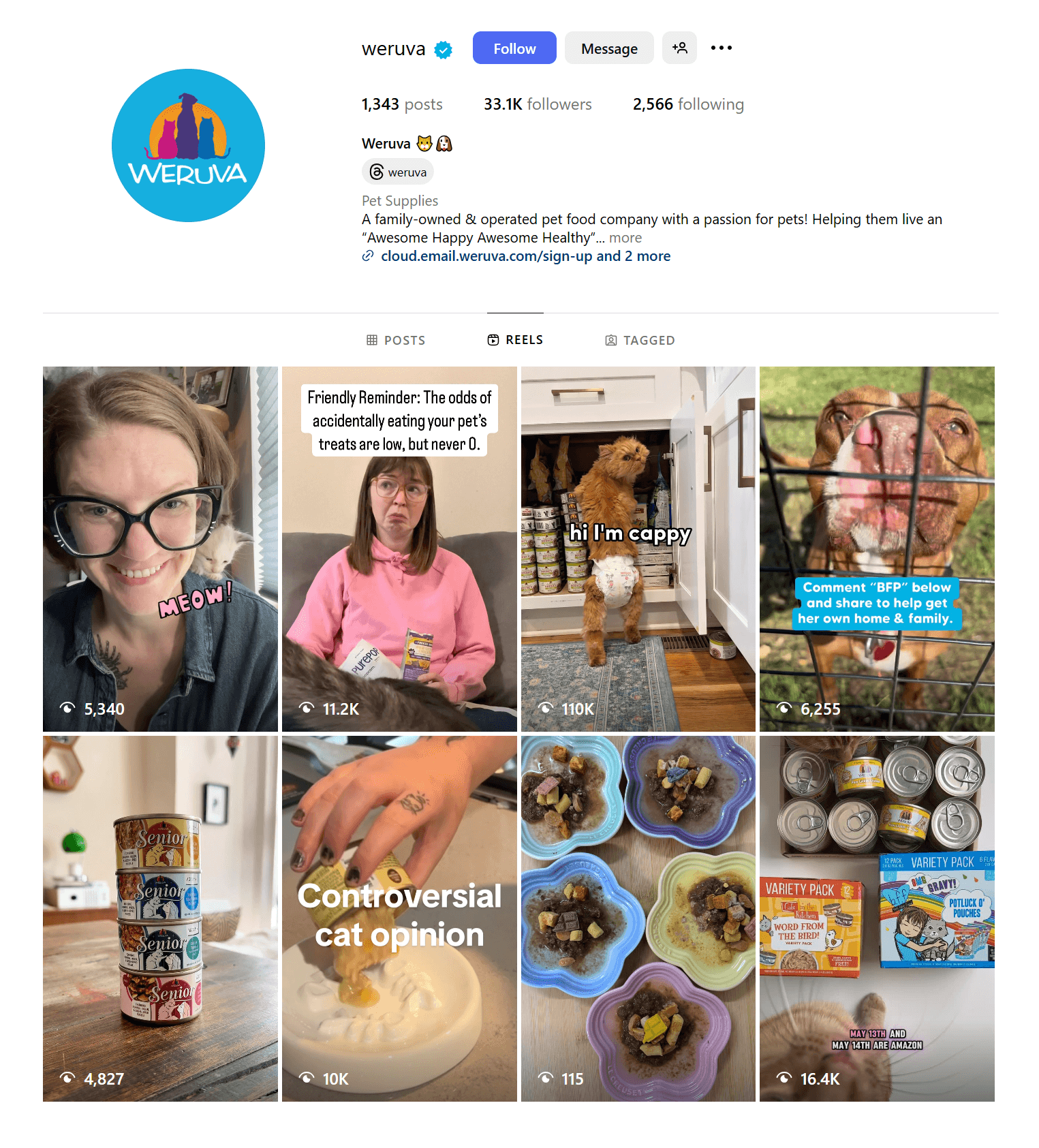
Tip: Post consistently, reply to comments, and use pet names when you can—it goes a long way.
Collaborate with influencers
Pet influencers and pet-loving creators can expand your reach fast. Don’t just aim for accounts with big numbers. Instead, look for engagement, authenticity, and relevance.
Here’s an example from Oncotect collaborating with Theycallmeferguson to raise awareness about cancer and promote their at-home cancer screening tests for dogs.
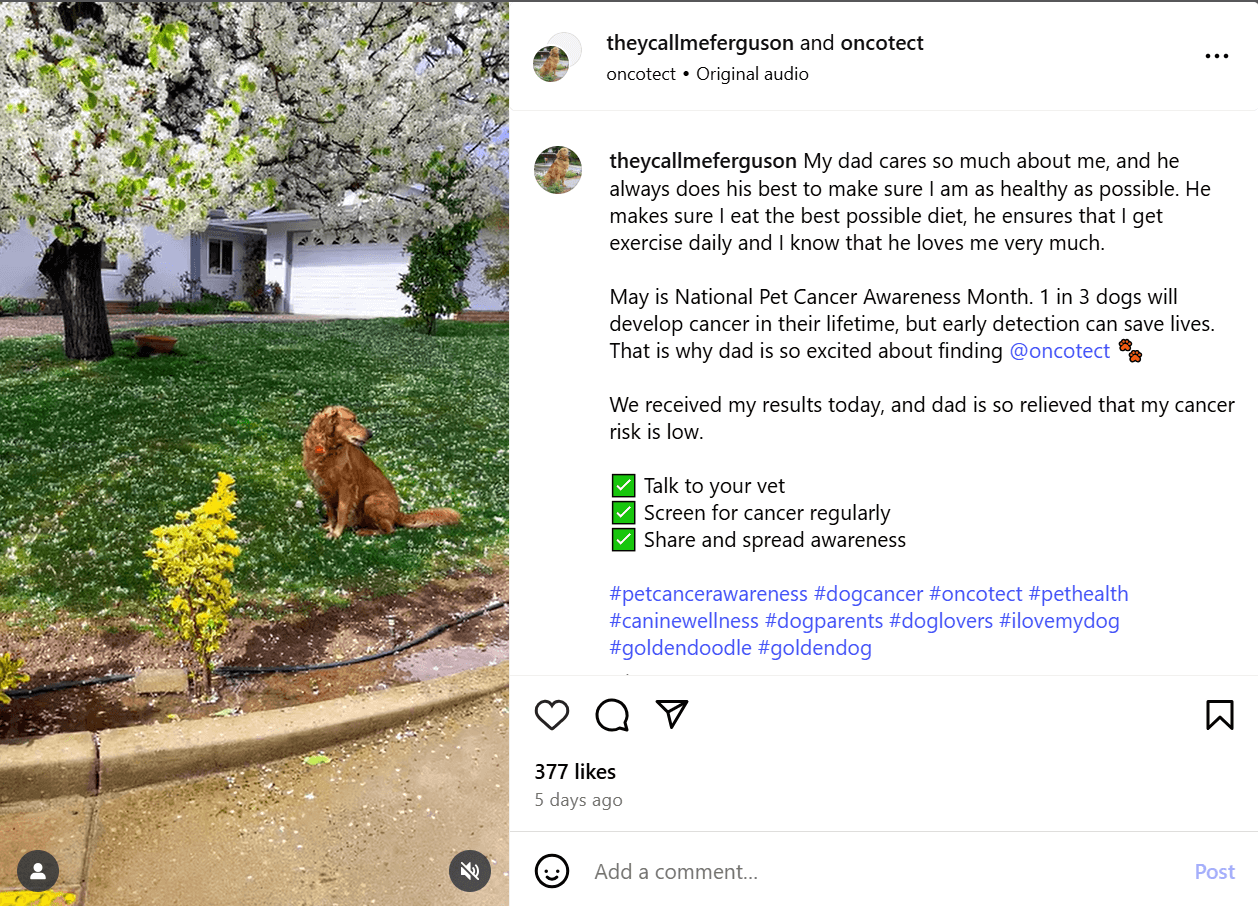
Tip: Partner with micro-influencers who share your values. Offer free services or products in exchange for content that feels real, not scripted. If they are already familiar with your product or services, then that’s a double win for you.
Run paid ads
Organic content builds trust, shows personality, and keeps your audience engaged over time. Paid ads, on the other hand, will help you reach more pet parents, especially when you’re launching something new or filling up your calendar.
Here are a few tips for running paid ads:
- Start small: Begin with a low daily budget (even $5–$10) and test what works.
- Use strong visuals: Cute pets and real customer images are more effective than stock photos.
- Keep your CTA clear: “Book Now,” “Shop Now,” or “Claim 10% Off Today.”
- Target smart: Use location, pet-related interests, and age groups that align with your customer base.
- Track results: Monitor performance (clicks, cost-per-click, bookings) and adjust as needed.
Further reading: For more, check our Facebook Lead Ads guide.
Website
Your website isn’t just there to list your services or products, but to guide, reassure, and convert your visitors.
A great example is Itch, which tailors its product recommendations through a simple quiz that collects the pet’s name, type, breed, and age.
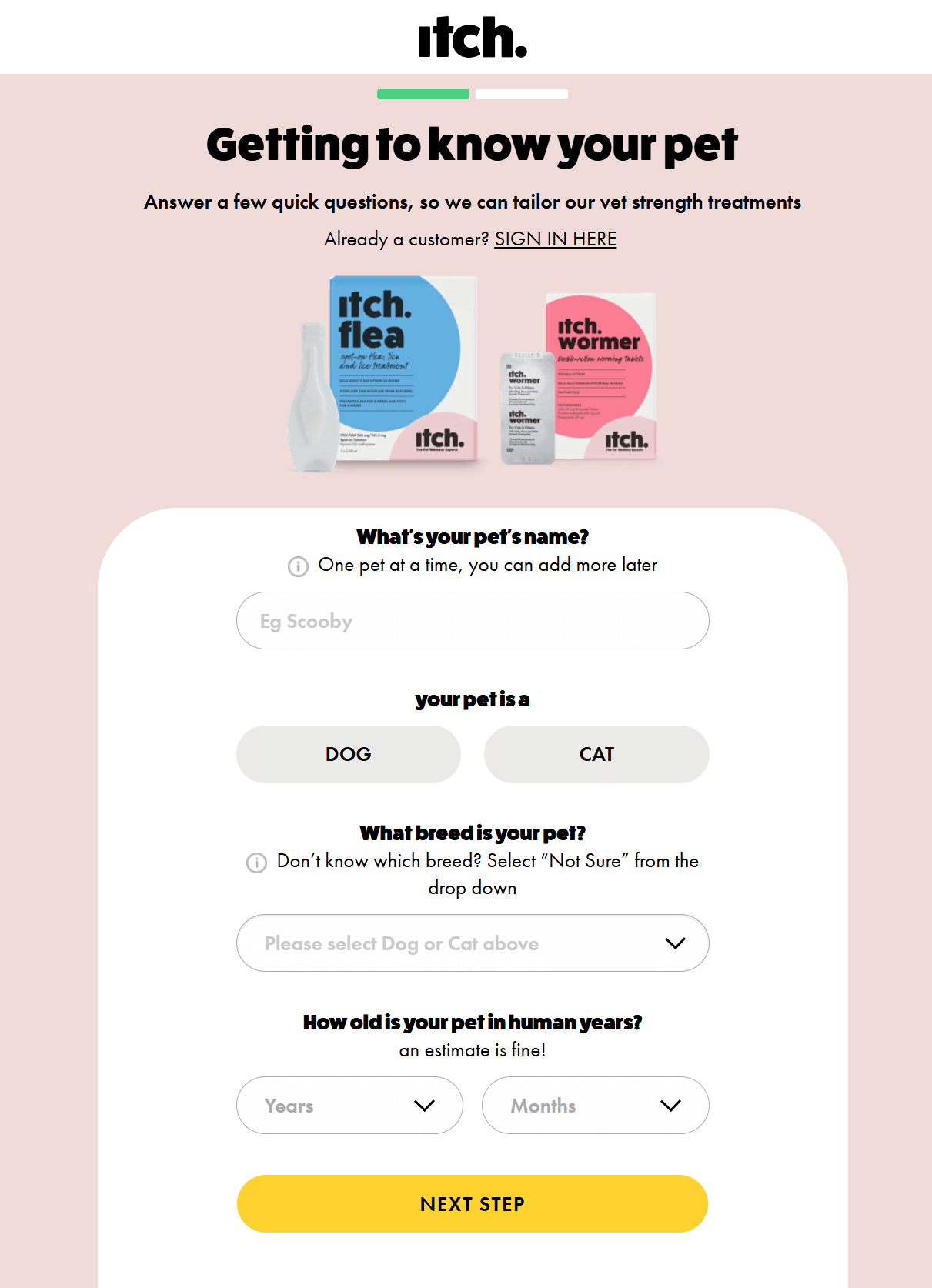
This allows them to recommend the most suitable flea or worm treatment based on actual data, rather than relying on guesswork. Plus, personalize the pet owner’s experience.
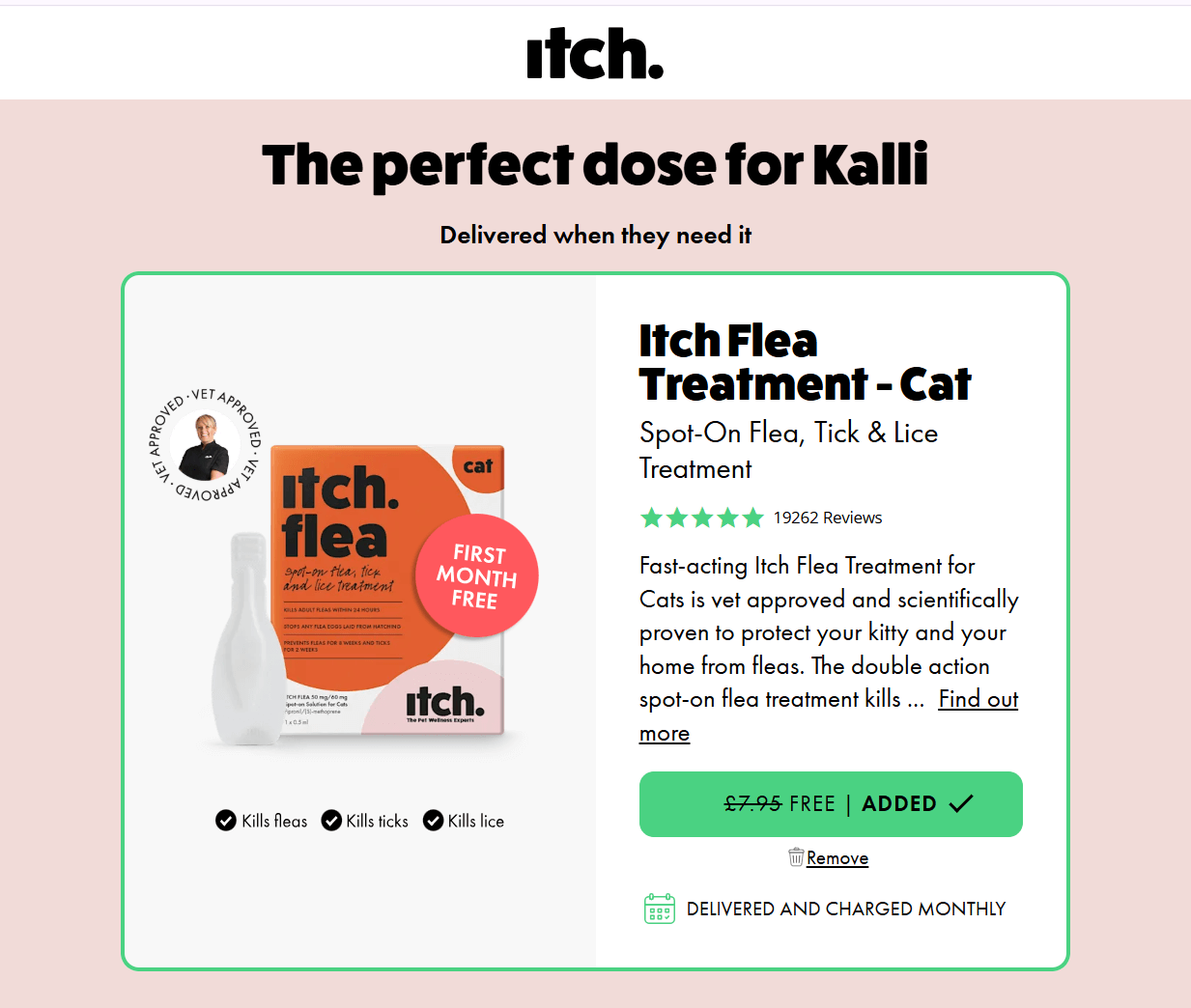
You can follow a similar approach by offering tailored suggestions based on pet type, size, or life stage, showcasing location-based services (like “Summer De-shedding in Miami”), or highlighting relevant products tied to browsing behavior.
Use clear, conversational language that speaks directly to the pet owner, making them feel seen and their furry friend cared for.
Lastly, you can use testimonials on your website to increase trust at key decision points.
For example:
- Add quick quotes near service descriptions
- Feature a “Pet Parent Stories” section with short blurbs or videos
- Include testimonials in your booking or checkout flow as reassurance
- Use breed-specific or service-specific reviews to show results
The most effective form of marketing is a satisfied customer who shares their positive experience with others. So, make it easy for them to speak and even easier for others to listen.
Content Marketing & Search Engine Optimization (SEO)
Your content should earn trust, answer real questions, and support every other part of your pet care marketing.
That’s where content marketing and SEO come in.
Think of your blog as a natural extension of your services. If you’re a groomer, write about how to prep dogs for their first appointment. If you sell supplements, clearly explain the ingredients and how they support your pet’s health.
A good example comes from Paws & Unwind Pet Resort. Their blog offers information on dog boarding, pet grooming, training, and more to educate pet owners.
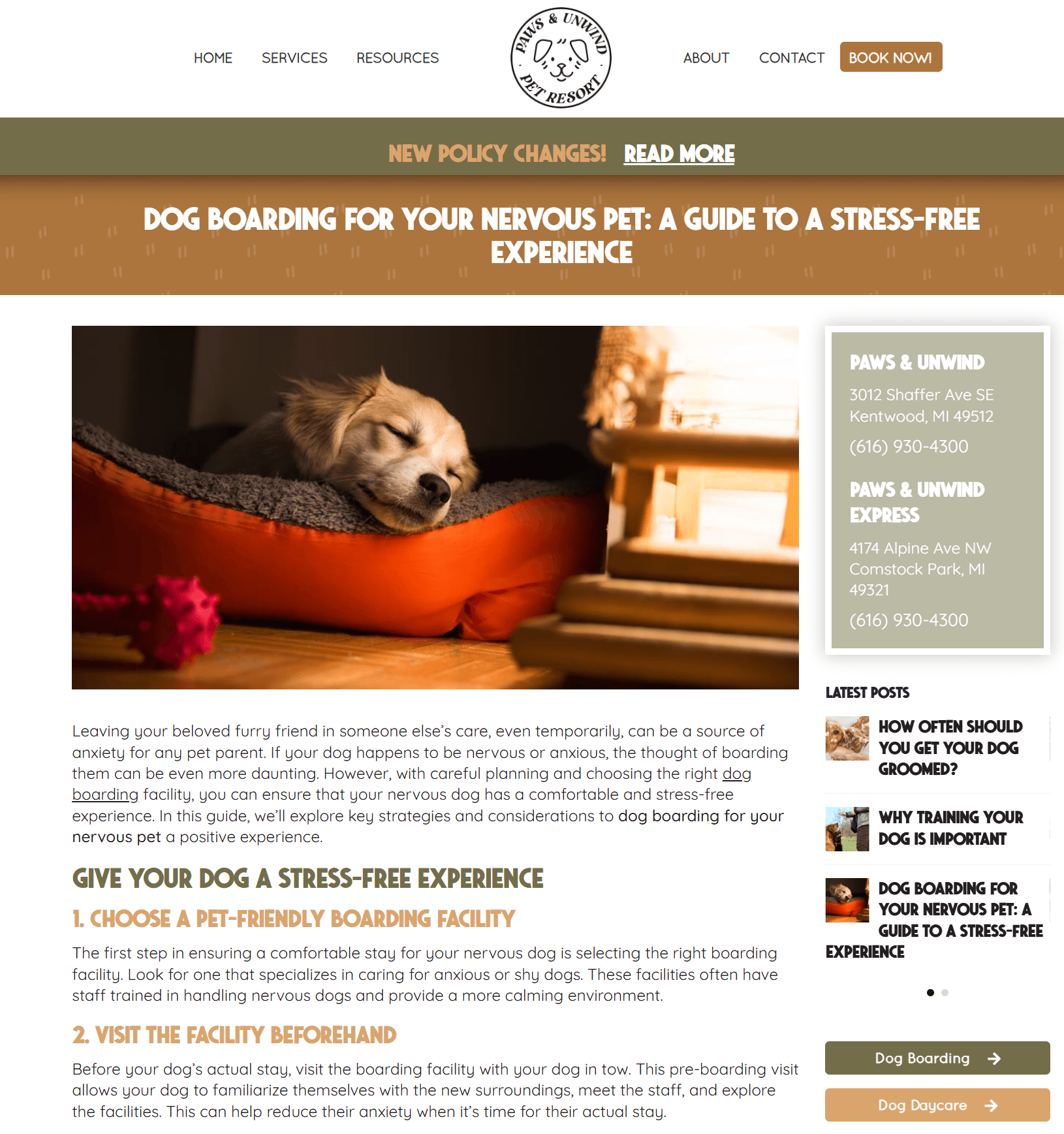
Content like this isn’t just educational, though. It can help you rank higher, drive traffic, and provide valuable content to share in emails and on social media.
That’s where SEO and keywords come in.
- Short-tail keywords are broad terms, such as “dog grooming” or “pet food.” These terms receive numerous searches but are highly competitive and may not always attract the right audience to your site.
- Long-tail keywords are more specific phrases, such as “best dog grooming for poodles in Chicago” or “how to choose grain-free food for senior cats.” These may have fewer searches, but the people typing them are typically ready to book or make a purchase.
Here’s how to approach SEO for your pet care business:
- Start with real questions: Look at your surveys, direct messages, emails, or the questions clients ask during appointments. Topics like “How often should I groom my dog?” or “What’s the best food for senior cats?” make great blog posts and FAQ pages.
- Skip the fluff: Use plain language that’s easy to skim. Pet parents don’t want jargon but helpful advice.
- Connect content to services or products: If you mention de-shedding tips, link to your grooming service for a seamless experience. When discussing digestion, mention the supplement you carry. Keep it helpful, not salesy.
- Use keywords where it makes sense: Include long-tail keywords, but only where they fit naturally. Google rewards relevance more than repetition.
SMS Marketing
Unlike emails or posts that might get lost in the inbox, a well-timed text will pop up right in front of your customers. This makes SMS marketing perfect for appointment confirmations, quick reminders, last-minute openings, or limited-time offers.
To integrate SMS into your pet care marketing strategy, follow these simple steps.
- Start with clear consent: Always obtain customers’ explicit opt-in. You can collect phone numbers at checkout, in online forms, or during bookings. Just make sure they know what they’re signing up for.
- Keep your list clean and organized: Segment your SMS list like you would with your email list. For example, send grooming offers to clients who booked in the past, or product restock alerts to customers who bought treats or supplements.
- Personalize when possible: A message like “Hi Sam, ready for Marley’s next nail trim?” feels way more personal than a generic blast.
- Use SMS for high-impact moments, including appointment reminders, flash sales or limited promos, order updates, delivery notifications or loyalty rewards.
- Keep messages short and actionable: Since you have limited space, say what matters, drop a link if needed, and make it easy to respond.
- Time it right: Avoid early mornings or late nights. Stick to mid-morning or early afternoon when people tend to be more responsive.
- Don’t overdo it: One to two messages a week is plenty unless your audience expects more.
SMS is fast, friendly, and one of the easiest ways to stay top of mind. However, it has its own limitations. Pair it with email marketing, and you’ve got instant reach, long-form storytelling, reminders, and deeper engagement.
Pet Care Marketing Isn’t Optional Anymore
Marketing your pet care business is about showing up with intention, creating real value, and building trust with every message you send.
When pet parents feel seen, they remember your brand. When your message lands at the right moment, they book. And when what you share helps them, they come back.
A kind welcome message, a quick reminder, or a helpful tip they didn’t know they needed will help you stay top-of-mind without trying too hard. All you have to do is make them thoughtful and personal.
If you’re ready to bring your pet care email marketing to life, Moosend gives you everything you need to make it happen. Sign up for a free account and start creating campaigns your customers (and their humans) will love.
FAQs
Below you’ll find answers to common questions regarding pet care marketing.
1. What is the pet care market?
The pet care market includes all products and services related to pets, like food, toys, grooming, daycare, training, and veterinary care. Currently, it’s a $303 billion market that continues to expand as more people treat their pets like family.
2. What is pet marketing?
Pet marketing is the strategy of promoting products or services to pet owners in a way that builds trust, encourages loyalty, and drives action. It can include everything from email and social media to SMS, SEO, and influencer partnerships.
3. How do you effectively market to pet owners?
Start by understanding their needs. Pet parents want to feel informed, supported, and confident in their choices. Use educational content, personalize your emails and texts, feature real pets in your visuals, and communicate like a fellow pet lover rather than a sales representative.
4. How profitable is the pet care industry?
With increasing demand for high-quality pet products and services, the industry has become a profitable space for both local businesses and online brands. Smart marketing helps you tap into that demand and stand out from the competition.
5. How do I evaluate my pet care marketing strategy?
Track key metrics like bookings, repeat visits, customer retention, open rates, click-through rates, and sales tied to specific campaigns. If you’re growing your audience, converting interest into action, and keeping pet parents engaged, your strategy is working.
6. How do I measure the return on investment (ROI) for my pet care business?
Compare what you’re spending on each marketing channel to its return on investment. For example, if your email campaigns cost $50 a month and generate $500 in bookings, your ROI is strong. Use tools like Google Analytics, your email platform’s reports, or booking software to track results more closely.
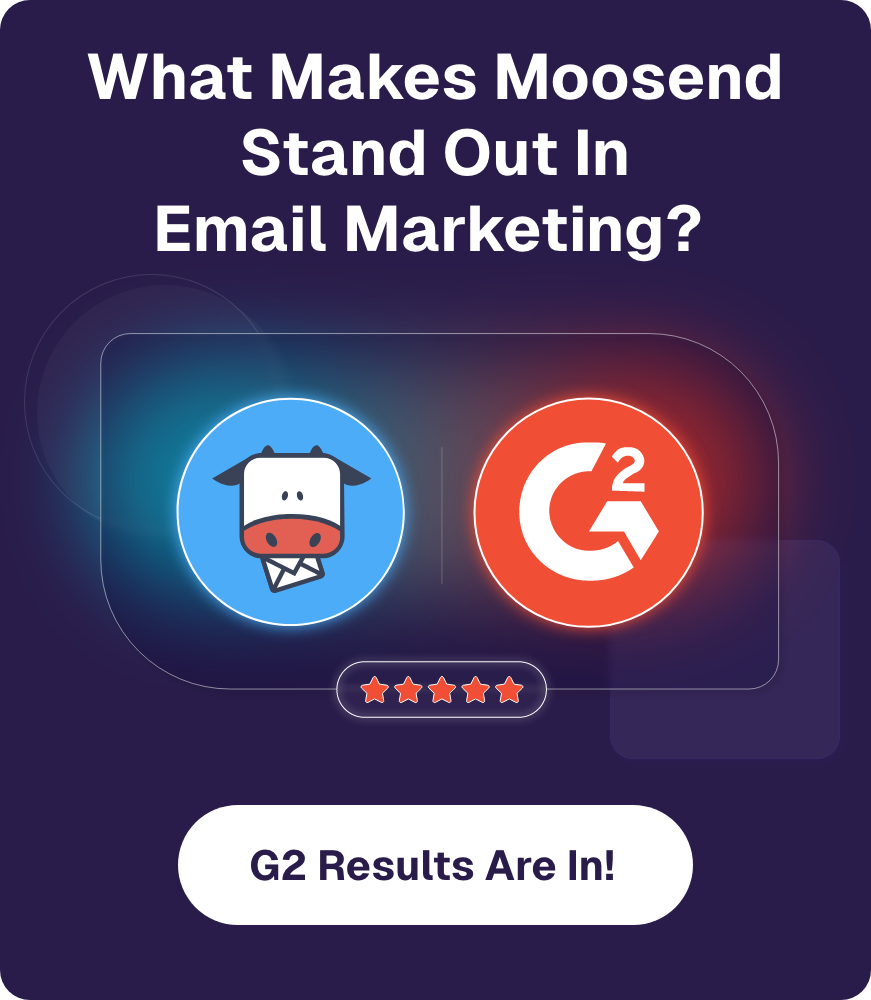



 Published by
Published by

 Published by
Published by